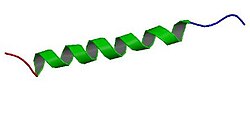Glucagon
1BH0, 1D0R, 1NAU, 2G49, 2L63, 2L64, 2M5P, 2M5Q, 3IOL, 4APD, 4ZGM
n/a
n/a
n/a
n/a
n/a
Glucagon is a peptide hormone, produced by alpha cells of the pancreas. It works to raise the concentration of glucose in the bloodstream. It is also used as a medication to treat a number of health conditions. Its effect is opposite to that of insulin, which lowers the glucose.
The pancreas releases glucagon when the concentration of glucose in the bloodstream falls too low. Glucagon causes the liver to convert stored glycogen into glucose, which is released into the bloodstream. High blood-glucose levels, on the other hand, stimulate the release of insulin. Insulin allows glucose to be taken up and used by insulin-dependent tissues. Thus, glucagon and insulin are part of a feedback system that keeps blood glucose levels stable. Glucagon increases energy expenditure and is elevated under conditions of stress. Glucagon belongs to the Secritin family of hormones.
...
Wikipedia


